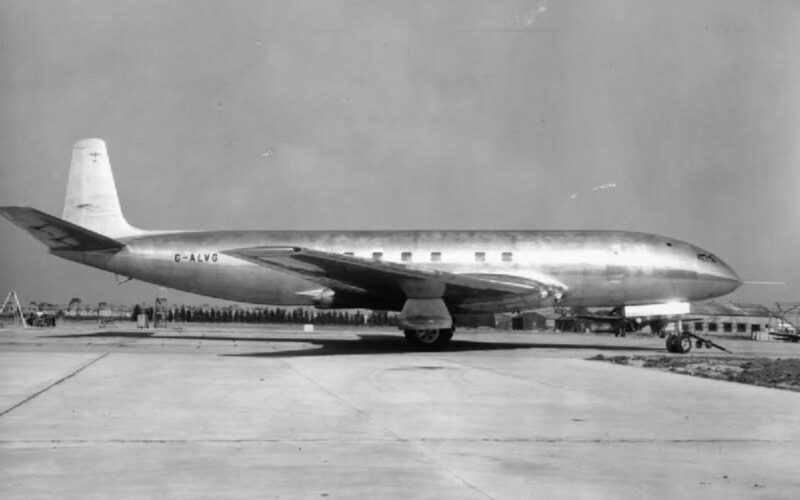It was a warm, calm day on July 27, 1949, in Hatfield, United Kingdom. The doors to a giant hangar opened and, through the gap, a sleek, metallic tail emerged. It glistened in the sunlight, inspiring awe and pride among the ranks of British reporters who had come to witness the unveiling at de Havilland’s private aerodrome.
That moment, perhaps more than any other, signified the beginning of the jet age in commercial aviation. Rather disappointingly, it was also more significant and far more impressive than the jet’s inaugural flight.
But the flight had not been planned for that particular day. The prototype had been conducting ground tests for a while and, after an extensive photoshoot, headed for the runway to embark on a few high-speed runs. Then, the Comet was parked at the end of the runway and, with brakes engaged, revved its engines to take-off power.
The press was fascinated by the high-pitched roar of the four Ghost turbo-jets. As the most powerful assortment of engines on any civilian aircraft of the time, it seemed like Science fiction made real. A few years prior, jet engines were completely unknown to the general public, a technology that was considered too expensive, too experimental and too secret to ever achieve mass-production.
Can you remember the so-called EmDrive? It was a seemingly impossible microwave thruster that created a sensation in the press during the early-2000s. Well, imagine if it was incorporated on the first experimental military aircraft in the 2010s and the first EmDrive-powered airliner, a hypersonic ultra-modern aircraft that looked like something straight out of Star Wars, was then rolled out in 2020, making every modern passenger obsolete in the process.
Through this analogy, we can try to understand how the people gathered at Hatfield Aerodrome on July 27, 1949 must have felt.
After the full-power test, de Havilland’s press officer notified the crowd that the event was over and the journalists made their way back to London. There was nothing else to see. But the demonstration of a streamlined, bare-metal fuselage and the power of four wonder-engines housed inside was still enough of a spectacle to warrant the 20-mile journey from London.
So, the journalists returned to their offices and the day was almost over. The Comet prototype made one more high-speed run but, this time, a short hop into the air was made. The airplane was piloted by John Cunningham, a war-time ace and the chef pilot of de Havilland. July 27 was his birthday.
It was also the birthday of Geoffrey de Havilland, the company’s owner and the driving force behind the Comet’s development. An early enthusiast of the jet engine, de Havilland was absolutely confident in his creation. So, why not mark the occasion with something even more spectacular?
For Cunningham, there was no reason not to attempt to fly the jetliner on that particular day and so, the decision was made. The jet wound up its engines once again, took off, climbed to 8,000 feet (2,440 meters) and then made a low-altitude, high-speed pass over the airfield. At least one camera was rolling, but the gaggle of reporters were already on their way back to London, and so, the people who were the most interested in witnessing the historic moment, actually missed it.
A few rather angry comments appeared in the daily newspapers on July 28, but even the initial demonstration was enough to convince the press of the gravitas of the moment. The roll-out, which incidentally coincided with the maiden flight, paved the way for the future of commercial aviation. To this day, a more significant moment for commercial aviation is yet to occur.
Sure, Comet’s image was tainted in just a few years, when the airplanes, hailed as the forerunners of the new age, started falling from the sky, one after another. And, yes, on the back of Comet’s failures, other popular jet airliners emerged and gained prominence.
But these aircraft owe their success to the Comet for not only showing what not to do, but because it also demonstrated what was possible.

